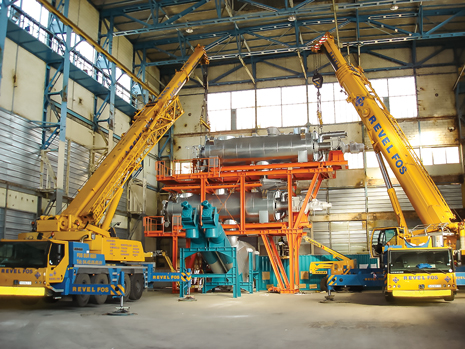 |
| The VacuDry system offers an economic way to treat drill cuttings. |
|
Drill cuttings are an ever-increasing waste stream generated by the upstream industry. In an attempt to limit the adverse environmental impact caused by the presence of drilling fluids in cuttings, efforts are being made worldwide to convert the cuttings to a non-hazardous material, which significantly eases the disposal process.
At the same time, drilling also requires large volumes of expensive fluids. In light of this situation, econ industries decided to test its VacuDry indirectly heated, thermal desorption unit for the recovery of drilling fluids from cuttings. The VacuDry process has been used for the treatment of a variety of oil-based wastes for a number of years.
In the following study, laboratory and field tests applying the batch-wise VacuDry process have been conducted. The TPH concentrations of the treated drill cuttings have been reduced, from 12,000 ppm to below 250 ppm, in the lab tests, and from 300,000 ppm to 640 ppm in the field tests. It was also discovered that the recovered oil is comparable to the original drilling fluid—hence, it can be reused for additional drilling. With an average energy consumption of only 170–230 kWh/t, the VacuDry system is about five times more energy-efficient than other thermal desorption systems. This combination—low energy consumption and the recovery of drilling fluids—makes the process an inexpensive alternative to existing treatment methods.
EXISTING METHODS
A number of drill cutting treatment technologies are already in use, Table 1. However, none of these methods provides completely satisfactory results.
| Table 1. Comparison of different technologies for the treatment of drill cuttings. |
|

|
Rotary kilns have been used for the treatment of oil wastes and drill cuttings for many years. However, in recent years, their application has been viewed with increasing scepticism. Rotary kilns operate with a very low level of energy efficiency. Therefore, the plants consume vast amounts of thermal energy, which leads to high operational costs. As a consequence of their inefficiency, rotary kiln units also produce high levels of emissions. Numerous environmental authorities, worldwide, no longer permit the use of this type of equipment. A further restriction is that rotary kilns can only deal with a maximum TPH content of around 3%. Therefore, input material with higher TPH contents often has to be mixed with inert material, to reduce the caloric load. Again, such methods increase the energy consumption per ton of treated material. Especially when talking about wastes with varying consistencies, an exact adjustment of the caloric value of the input material is required but difficult to achieve. In the past, incorrect adjustment of caloric values, as well as unsafe handling by the operating staff, has resulted in serious fire outbreaks and damage.
Hammer mills are often used to treat drill cuttings. However, their applicability is restricted by the limited temperature, around 250°C, since the desorption temperature is only achieved through friction within the mill. Here again, it must be considered that desorption of the contaminants takes place under atmospheric pressure. Due to the low temperature and the absence of any form of vacuum, this technology is not suitable for drill cuttings containing heavier oil fractions, as the resultant TPH content present after the treatment is often too high. On the other hand, the wear on the hammers is significant, and the related maintenance times, as well as the worn part costs, are high.
A lot of research has been carried out on the use of bioremediation as a treatment alternative for drill cuttings. Where only light fuel oils, up to diesel fractions, are present, this technology can work under favorable ambient conditions. However, due to the long time required for treatment, the vast space requirements, and the very specific demands on the input material and climate conditions required, this methodology is seen as impracticable. In addition, the treatment targets are often not met.
In the liquid solid extraction process, contaminants are extracted by process fluids from the solid matrix. Usually, detergents containing water are used as process fluid. For drill cuttings with a high oil content, being bound firmly to the soil matrix, this technology faces many problems. One of this system’s major disadvantages is the large volume of expensive detergents required. As the detergents are, usually, hazardous to water, they have to be separated, and a sophisticated wastewater treatment system has to be employed. In addition, the quality of the final treated material is often insufficient, especially for fine material containing heavy oil fractions.
NEW RECOVERY METHOD
For this study, tests have been conducted, using the VacuDry indirect heated vacuum thermal desorption technology. In this process, heat and a controlled vacuum are applied to evaporate substances having a boiling point of up to 450°C (under atmospheric pressure), Fig. 1. Due to the vacuum, the boiling point of substances is considerably lower when compared to atmospheric pressure. Due to the fact that the VacuDry system runs in a batch-style process, each process can be fine-tuned and is extremely flexible. This allows for adjustment and optimization of the batch process to suit the characteristics of each input material.
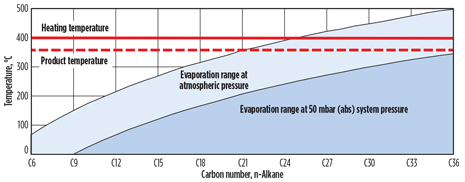 |
| Fig. 1. A comparison of hydrocarbon boiling points under 50 mbar (abs) (vacuum), atmospheric pressure (simplified). |
|
To heat up the evaporator, temperature-resistant synthetic oil is circulated inside the evaporator´s heating jacket and central shaft. The rotating shaft, inside the still-standing cylindrical evaporator vessel, ensures intensive mixing during the process. Due to this, a highly-efficient heat transfer to the product can be achieved, and short, energy-saving batch times can be realized.
Following the vaporization of water and hydrocarbons, the exhaust stream is led through a vapor filtering unit, to prevent dust from merging with the vapors. Specially designed heat exchangers separate the vaporized substances from the main vapor stream by condensation, using indirect cooling. For the individual recovery of valuable substances, gradual heating assures their defined separate evaporation and condensation.
Laboratory tests. During July 2006, econ industries carried out laboratory tests, using two different types of drill cuttings from the North Sea, Table 2. One hundred liter samples have been treated batch-style in a VacuDry 140, at product temperatures up to 300°C and a pressure, inside the vacuum desorber, of down to 50 mbar (abs). The required retention time to achieve the result required by the client was 350 min.
| Table 2. Composition of the input material from the laboratory tests. |
|

|
Field tests. A test utilizing 100 tons of drill cuttings, from German gas fields, was successfully completed in August 2013. The plant used was a VacuDry 12,000 x 2. This plant was, originally, designed for the treatment of grinding swarfs from the metal industry. And due to the auger’s extremely high level of torque, the plant is especially suited to treating pasty and sticky material, such as drill cuttings. Sixteen-ton batches of drill cuttings have been treated in one econ VacuDry 12,000-liter evaporator, at product temperatures of up to 250°C and a pressure below 50 mbar (abs).
RESULTS
Laboratory tests. During the tests, two distinct main process phases—water evaporation and oil evaporation—were observed, Table 3.
| Table 3. Evaporation phases during the laboratory tests. |
|

|
The results outlined in Table 4 were achieved. Both samples were processed for 350 min. within the laboratory plant. However, the point where only negligible amounts of liquids were evaporated occurred much earlier—after 248 min. for sample A and after 269 min. for sample B. Therefore, shorter batch times are possible, Figs. 2, 3 and 4.
| Table 4. Total petroleum hydrocarbons (TPH)-value (C10-C40) of output material (DIN ISO 16703). |
|

|
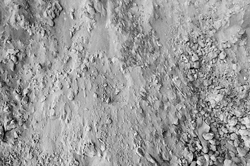 |
| Fig. 2. Processed material (sample A). |
|
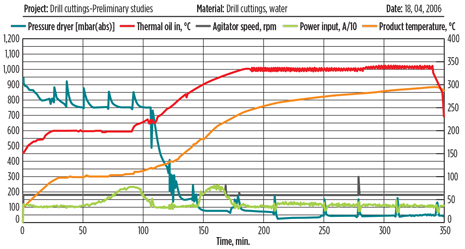 |
| Fig. 3. Trial chart laboratory test for sample A. |
|
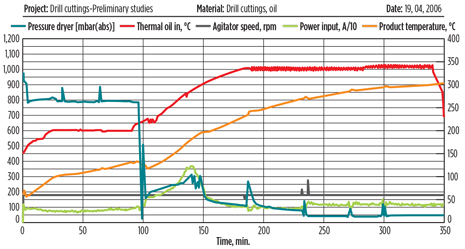 |
| Fig. 4. Trial chart laboratory test for sample B. |
|
Field tests. During field testing, the results in Table 5 were achieved.
| Table 5. Total petroleum hydrocarbons (TPH)-value (C10-C40) of output material (DIN ISO 16703). |
|

|
CONCLUSIONS
Both the laboratory and field tests demonstrated that the VacuDry process performed extremely well. Drill cuttings, with different oil and water content, can be treated in short batch times, less than 5 hr, making the technology very economical. A final TPH content of 250 ppm, from the lab test, was well within the given limits. The 640-ppm level is also satisfactory. The recovered oil is of high quality and can be reused for drilling applications.
However, there is still room for improvement. During both the laboratory analysis and the field tests, the heating temperature was limited to 330°C and 270°C, respectively. During the lab test, the heating temperature was limited because of technical reasons. In the field tests, the operators, who were unfamiliar with the new material, operated the plant far below its technical capability of 400°C.
Therefore, by increasing the heating temperature to 400°C, the TPH value of the output material will be lowered significantly while, at the same time, the batch time will be reduced considerably. From an economic standpoint, this will make the VacuDry system superior for the treatment of drill cuttings. 
|











